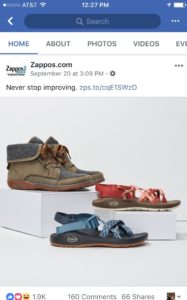I love shoes. (It’s kind of a problem.) I’ve run out of room in my closet and mudroom. My shoe racks are full i and yet I still keep buying more, justifying each purchase as an imaginary business expense or a way to handle the changing New England seasons.
Toms and Zappos.com are my go-to sites for shoe shopping. I know that if I browse either site (say for a new pair of chukka boots), the next day my Facebook feed will be filled with similar items that are just one click away from purchasing.

Companies are investing billions of dollars in social outreach. They’re connecting customer interests and engagement to real dollars, and they’re doing very well at it, with more outreach and marketing spend dedicated to social media every year.
Social insights are powerful. Thanks to my engagement, Zappos knows when I’m interested in making a purchase, and they reach out with the right offer at the right time to make the sale.
So why does advancement lag behind when it comes to connecting social interactions to real engagement, donors, and dollars?
We’ve fallen behind because many universities have not aligned the efforts of their marketing and communications teams with the goals of development and alumni relations.
But there’s an exciting movement happening. Forward-thinking institutions are beginning to connect social engagement to volunteer recruitment, annual fund appeals, and major gift pipeline — the lifeblood of advancement.
Boston University, for example, has invested heavily in digital. Its team has demonstrated that social outreach is an effective way to reach more donors and engage more alumni. Here’s a taste of what they’re doing.
“Likes” lead to gifts
When BU kicked off a project to convert an iconic, 100-year-old building known as the “Castle” into a new Alumni Center, the team announced the news on Facebook and published a series of posts about the building, resulting in hundreds of likes and comments.
The Boston University team then used these interactions to create lists of potential donors for the $5 million project. The team found that alumni who had interacted with Castle-related posts had a 75 percent conversion rate at its phonathon, more than doubling its typical conversion rate of 30 percent.
Connecting with donors when they connect with you
As a way to raise critical support for financial aid, the BU team regularly shares videos on Facebook featuring scholarship students, then reaches out via email to contacts who react or comment on these stories. The resulting email solicitations, which promote the impact of financial aid, have an average open rate of 36 percent and gifts to scholarship funds are up seven percent year-over-year.
In both cases, the Boston University engagement and annual fund teams are working together to drive meaningful results. Like a for-profit business, the team uses Facebook as an engagement tool, then connects the interactions with alumni, parents, and friends to gift opportunities. They’re generating results by matching institutional priorities with known donor interests.
Recruiting volunteers from your most-engaged audience
This targeted approach to fundraising also played out for volunteer recruitment for Boston University’s annual Giving Day. In the month leading up to this year’s Giving Day, BU promoted the event on social and created lists of constituents who engaged with the posts.
The team then used those lists to build a Facebook ad asking alumni to become ambassadors and help spread the word about Giving Day. The message to the socially engaged supporters paid off: BU grew its team of ambassadors to 380 people, which represented a 52 percent year-over-year increase and helped the school achieve a record-breaking Giving Day of $2.3 million raised from 11,500 gifts.
Isn’t this exciting?
This movement that’s sweeping across the advancement industry is thrilling. We’re seeing tactics from for-profit leaders (hello Zappos!) transition to the nonprofit world where they’re often even more effective, since we’re talking with alumni who are by definition excited to partner in the work we’re doing.
This is only just the beginning. We’ve seen response rates from new major gift prospects skyrocket if they’re also engaged on Facebook. Scholarships and professorships have received funding. We’ve seen $1m bequests and large gifts come in as the result of a donor liking content. And we’re watching the reinvention of the annual fund.
Every day, we hear new stories from schools that are joining this movement and leveraging social insights to power their advancement work. (If you’re one of them, we want to hear from you! Email me or leave a comment.)
Watch Stephanie Quinn, director of annual giving; Kristy Kime, associate director of online engagement; and Phil DiMartino, associate director of annual giving (digital programs) of Boston University for this can’t-miss webinar: Social Insights for Advancement, Wednesday, Oct. 25 at 2 p.m.
Mike Nagel used to be the associate director of digital marketing at Phillips Exeter Academy. Now he’s the customer marketing manager at EverTrue. Connect with him on Twitter or LinkedIn.